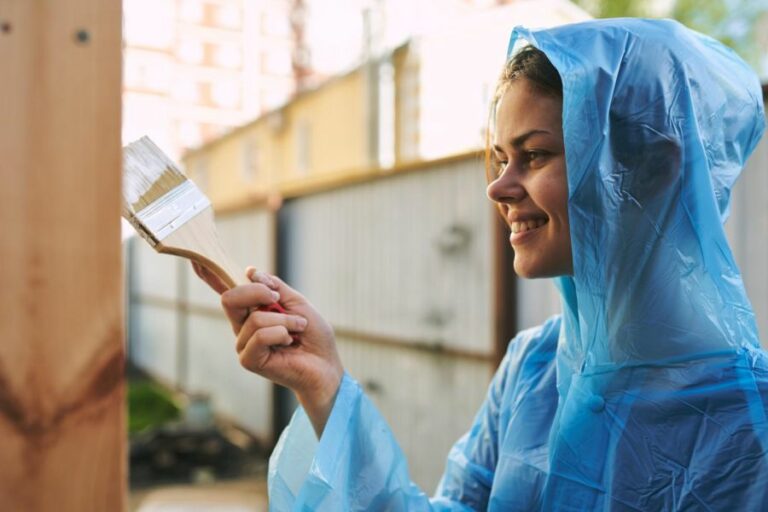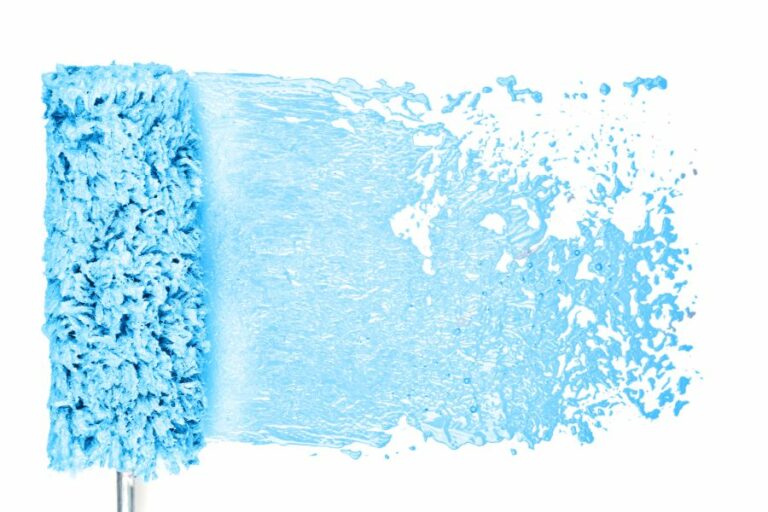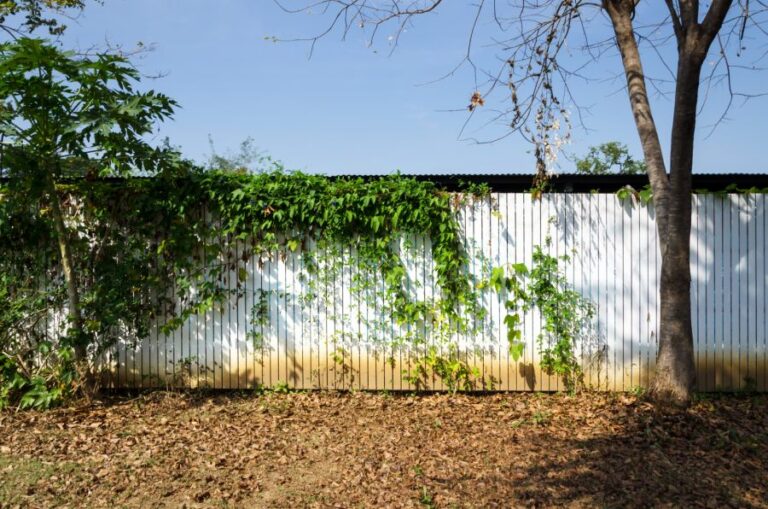Paint For Outdoor Stairs, 25 Things You Should Know
Looking for a stylish and durable way to revamp your outdoor stairs? Look no further! Here’s your ultimate guide to choosing the perfect paint that adds charm and sophistication and can withstand harsh weather and heavy foot traffic. I’ll discuss must-have features such as non-slip, UV resistance, water repellent, and more – ensuring your staircase remains safe and vibrant all year.
Paint for outdoor stairs:
When painting outdoor stairs, choose a paint that is not only visually appealing but also offers protection, durability, and slip resistance. There are two primary types of paints to consider: acrylic (water-based) and oil-based paints, each with advantages and disadvantages. Select exterior-grade, mildew and algae-resistant, weather-resistant, and slip-resistant paint specifically designed for outdoor stairs. Proper surface preparation ensures long-lasting protection, including cleaning, sanding, filling in cracks, and priming. Porch and floor paint is a suitable option for outdoor stairs, with popular products including Behr Premium Porch & Patio Floor Paint, Valspar Porch, Floor & Patio Latex Paint, and Rust-Oleum Porch & Floor Coating.

Discover the perfect paint for outdoor stairs and elevate your exterior space. Uncover the best products, application tips, and maintenance essentials to ensure longevity and safety in this comprehensive guide. Transform your steps today!
Contents
- 1 Exterior Staircase Paint for Outdoor Use
- 2 What type of paint should be utilized for exterior staircases?
- 3 What is the Most Suitable Paint Choice for Exterior Staircase Risers?
- 4 What is the Most Suitable Paint for Porch Steps?
- 5 Is it Possible to Paint Exterior Staircases?
Exterior Staircase Paint for Outdoor Use
When painting outdoor stairs, the type of paint you choose can make all the difference. Not only should the paint be aesthetically appealing, but it should also provide protection, durability, and slip resistance to help ensure the safety of those who use the stairs.
• Understanding the Different Types of Paint
Before you start shopping for paint, it’s essential to understand the different types of paint on the market and their specific purposes. There are generally two primary types of paints for outdoor stairs: acrylic (water-based) and oil-based paints.
– Acrylic (Water-Based) Paints
Acrylic or water-based paints are typically an excellent choice for outdoor stairs due to their excellent adhesion, flexibility, and weather resistance. Furthermore, these paints take a shorter time to dry and produce less odor than their oil-based counterparts, making them an eco-friendly and convenient option.
Advantages
- Faster drying
- Easy cleanup with water
- Lower in odor and volatile organic compounds (VOCs)
- Resistant to yellowing
- Excellent UV resistance and color retention
Disadvantages
- May require multiple coats for adequate coverage
- Can be less durable than oil-based paints
– Oil-Based Paints
Oil-based paints are another option to consider for outdoor stairs. Although they generally take longer to dry than water-based paints, oil-based paints are known for their durability and resistance to harsh weather conditions.
Advantages
- Exceptional durability
- Good coverage with fewer coats
- Resistant to wear and tear
Disadvantages
- Longer drying time
- Strong odor and high VOCs
- Requires paint thinner for cleanup
- May become brittle and crack over time
• Choose Paint Specifically for Outdoor Stairs
When selecting paint for outdoor stairs, look for products explicitly designed for exterior use. These paints typically contain ingredients that help resist damage caused by UV rays, moisture, and temperature fluctuations.
In particular, look for paint products labeled with the following features:
- Exterior-grade: Specifically formulated for outdoor use
- Mildew and algae-resistant: Helps prevent the growth of fungi and other unsightly growths
- Weather-resistant: Protects the surface from rain, snow, and extreme temperatures
- Slip-resistant: Contains additives like sand or grit to increase traction and prevent slipping
• Prepping the Stairs for Painting
Before applying any paint on your outdoor stairs, make sure to prepare the surface adequately. Proper surface preparation is crucial for ensuring that the paint adheres well to the surface and provides long-lasting protection.
- Clean the Stairs: Use a stiff brush or power washer to remove any dirt, debris, or loose paint from the stairs. Ensure the stairs are completely dry before moving on to the next step.
- Sand the Surface: Use a medium-grit sandpaper to sand any rough spots or remaining paint residue. This step helps create a smooth and even surface for the paint to adhere to.
- Fill in Cracks: If there are any cracks or holes in the stairs, use an exterior-grade wood filler or concrete filler to repair them. Follow the manufacturer’s instructions for drying time.
- Prime the Surface: Apply a quality exterior primer to the stairs, giving special attention to any bare wood or concrete areas. Priming helps seal the surface and improve paint adhesion.
• Application Tips
Below are some essential tips to ensure a successful outcome when painting your outdoor stairs:
- Choose the Right Tools: Use a high-quality brush, roller, or paint sprayer for an even and smooth paint application.
- Apply Multiple Coats: Apply at least two coats of paint to ensure adequate coverage and protection. Allow the paint to dry completely between coats as per the manufacturer’s instructions.
- Paint in the Right Conditions: Aim to paint when temperatures are between 50F and 90F, and avoid painting during high humidity, rain, or direct sunlight.
• Recommended Product: Porch and Floor Paint
In my experience, I have found that porch and floor paint is an excellent option for outdoor stairs. This type of paint is specifically designed for high-traffic areas exposed to the elements and typically contains additives to provide a slip-resistant surface.
Some popular porch and floor paint products include:
- Behr Premium Porch & Patio Floor Paint: This acrylic paint offers excellent durability and weather resistance and is available in a variety of colors and finishes, including a low-luster enamel finish.
- Valspar Porch, Floor & Patio Latex Paint: This paint is acrylic-based and offers excellent scuffing, fading, and cracking resistance.
- Rust-Oleum Porch & Floor Coating: This oil-based paint provides excellent wear resistance and durability, suitable for wood and concrete stairs.
By following these guidelines and recommendations, you can confidently choose the best paint for your outdoor stairs project and enjoy a beautiful, safe, and durable result for years to come.
What type of paint should be utilized for exterior staircases?
Outdoor stairs are exposed to harsh elements like rain, snow, and sunlight, which can take a toll on their condition. To protect your stairs and enhance their durability, it’s crucial to use appropriate, high-quality paint designed for outdoor use.
• Oil-Based vs. Water-Based Paints
Outdoor stair surfaces can be painted using oil- or water-based (acrylic or latex) paints. Each has its own strengths and weaknesses, which I will address in this section to help you make the right choice for your needs.
– Oil-Based Paints
Oil-based paints are known for their durability and long-lasting finish. They contain more binders and solvents, making them an excellent choice for outdoor stairs. They offer several benefits, including:
- Long-Lasting Protection: Oil-based paints provide a thicker, more durable coating that can withstand severe weather conditions and resist fading, chipping, and peeling.
- Superior Adhesion: These paints adhere well to various surfaces, making them suitable for stairs made of different materials such as wood, metal, or concrete.
- Smooth Finish: Oil-based paints tend to self-level while drying, resulting in a smooth and professional finish without visible brush or roller marks.
However, oil-based paints also have some downsides:
- Longer Drying Time: These paints take longer to dry, extending the time required to complete your painting project.
- Higher VOCs: Oil-based paints release volatile organic compounds (VOCs) that can be harmful to the environment and your health, especially when used in large quantities.
- Cleanup: To clean brushes, rollers, or other tools, you will need to use mineral spirits or paint thinner.
– Water-Based Paints
Water-based paints, such as acrylic and latex, are an increasingly popular option for outdoor stair applications due to their quick drying time and ease of use:
- Eco-Friendly: Water-based paints have lower VOC levels than oil-based paints, making them more environmentally friendly.
- Fast Drying Time: These paints dry faster, allowing you to complete your painting project more quickly.
- Easy Cleanup: Soap and water can easily clean brushes, rollers, and other tools.
- Resistance to Cracking and Yellowing: Over time, water-based paints are less likely to crack or yellow, maintaining their fresh appearance longer.
The main disadvantage of water-based paints is that they may be less durable and provide less protection than oil-based alternatives.
• Non-Slip Additives
Outdoor stairs can become a safety hazard when wet or icy. To minimize the risk of slips and falls, choosing a paint that can accommodate non-slip additives is essential. These specialized additives are mixed into the paint before application, providing a textured finish with increased traction.
Oil-based and water-based paints can be modified with non-slip additives, so whichever type of paint you choose, always consider incorporating a non-slip additive for added safety.
• Choosing the Right Paint for Your Outdoor Stairs
When selecting the best paint for your outdoor stairs, consider several factors:
- Surface Material: Different paints adhere differently to various materials. Be sure to choose a paint that is appropriate for the specific surface of your stairway, whether it’s wood, metal, or concrete.
- Climate and Weather Conditions: Consider your local climate and the predominant weather conditions your stairs will be exposed to, and select a paint that is designed to perform well under those circumstances.
- UV Resistance: Look for a paint with built-in UV protection, as this will help to prevent color fading and damage caused by sun exposure.
- Color and Finish: Choose a paint color that complements the exterior of your home and surrounding areas. You can also decide between different finishes, such as matte or glossy, based on your preferences and the stairs’ intended look.
• Application Tips for Best Results
Achieving professional-quality results when painting your outdoor stairs relies on a few key factors:
- Preparation: Before starting your painting project, make sure your stairs are clean, dry, and free of any loose paint or debris. You may need to use a pressure washer, wire brush, or sandpaper to prepare the surface appropriately.
- Primer: Applying a high-quality primer before painting can significantly improve adhesion and ensure a better final result.
- Application: Use a suitable brush or roller to apply your chosen paint, following the manufacturer’s guidelines for coverage and number of coats. Remember to mix in any recommended non-slip additives before application.
- Maintenance: Regularly inspect your stairs for signs of wear or damage and touch up the paint as needed to maintain their appearance and protective qualities.
In conclusion, choosing the right type of paint for your outdoor stairs is essential to ensure their durability and protection against the elements.
Consider the material of your stairs, local weather conditions, and personal preferences when selecting between oil-based and water-based paints, and always use a non-slip additive for added safety.
Following these guidelines and proper application techniques can achieve a long-lasting and attractive finish for your outdoor stairway.
Type | Description |
|---|---|
Acrylic Latex Paint | Water-based, durable, and resistant to fading and peeling. Provides a smooth, easy-to-clean surface. |
Oil-Based Paint | Long-lasting and durable but may not be as environmentally friendly as water-based paint options. |
Non-Slip Paint | Adds traction to outdoor stairs, reducing the risk of slips and falls. Can be found in both water and oil-based varieties. |
Deck and Floor Paint | Specifically designed for outdoor surfaces, providing protection against harsh weather conditions and heavy foot traffic. |
Exterior Wood Stain | Offers a more natural look while still providing protection and water resistance for wooden stairs. Can be combined with a sealant for additional durability. |
What is the Most Suitable Paint Choice for Exterior Staircase Risers?
When looking to refresh the appearance of your exterior stair risers or improve their durability and weather resistance, the type of paint you choose plays a crucial role in determining the outcome.
Not all paints are created equal, and with so many options on the market, it can be challenging to determine which is the best paint for your needs.
• Latex vs. Oil-Based Paints
Understanding the differences between latex and oil-based paints is essential when selecting the best option for your exterior stair risers. Each type of paint has its unique characteristics, making it suitable for particular applications.
– Latex Paints
Latex paints are water-based and are known for their ease of application, quick drying time, and low odor. They are easy to clean and maintain, as well as being environmentally friendly. Additionally, latex paints have better resistance to UV rays, preventing fading and discoloration over time.
Recommended latex paint for exterior stair risers: Acrylic Latex Paint.
Acrylic latex paint is known for its excellent adhesion and durability qualities. It also has superior weather resistance and blocks out moisture effectively. These attributes combine to make acrylic latex paints an excellent choice for exterior stair risers.
– Oil-Based Paints
Oil-based paints, also known as alkyd paints, are made from a mixture of oils and solvents. They take longer to dry than latex paints, emit a stronger odor, and require a thinner for proper clean-up.
However, oil-based paints are more resistant to wear and tear, making them ideal for heavy foot traffic areas such as stair risers.
Recommended oil-based paint for exterior stair risers: Alkyd Enamel Paint.
Alkyd enamel paints are known for providing a hard, durable finish with excellent resistance to wear and weathering. They also adhere well to various surfaces, making them a solid choice for exterior stair risers.
• Considering Sheen Levels
The sheen level of the paint you choose will also significantly impact its appearance and durability. Generally, the three types of sheens suitable for exterior stair risers are flat, semi-gloss, or gloss.
– Flat Paints
Flat paints, also known as matte paints, create a non-reflective surface that hides imperfections well. However, they are not as durable as semi-gloss or gloss finishes and may be more challenging to clean. Flat paints may not be the best option for exterior stair risers as they are prone to damage.
– Semi-Gloss Paints
Semi-gloss paints are a balance between flat and gloss finishes, offering a slightly reflective surface that is relatively easy to clean. They are more resistant to moisture than flat paints and are generally the most popular choice for exterior stair risers.
Recommended semi-gloss paint for exterior stair risers: Exterior Semi-Gloss Enamel.
This type of paint combines the best qualities of latex and oil-based paints, offering excellent adhesion, durability, and weather resistance. The semi-gloss finish adds an attractive sheen that is simple to maintain.
– Gloss Paints
Gloss paints provide a highly reflective surface, making them ideal for areas that are exposed to wear and tear. They are incredibly durable and easy to clean but may highlight imperfections on the surface. Gloss paints can be an excellent option for exterior stair risers in high-traffic areas.
Recommended gloss paint for exterior stair risers: Exterior Gloss Enamel.
This paint type offers the same impressive characteristics as semi-gloss enamel but with a higher sheen level. Its excellent durability and low maintenance make it an excellent choice for heavy foot traffic areas.
• Prepping the Surface for Painting
Before painting exterior stair risers, it is essential to prepare the surface properly to ensure the paint adheres well and lasts a long time. Here are some recommended steps for surface preparation:
- Clean the surface: Remove any dirt, dust, debris, or loose paint using a brush or pressure washer.
- Repair any damage: Fill any cracks or holes using an exterior-grade filler, then sand smooth once the filler is dry.
- Sand the surface: Sand the entire surface to improve adhesion and ensure a smooth application.
- Apply a primer: Choose a quality exterior primer that is compatible with the selected paint type and apply it to the stair risers.
Once the surface is prepared and the primer is dry, you can proceed with painting the exterior stair risers using your chosen paint.
• In Conclusion: The Best Paint for Exterior Stair Risers
Based on our experience, the most suitable paint for exterior stair risers is Exterior Semi-Gloss Enamel. It combines the benefits of latex and oil-based paints, offering excellent durability, adhesion, and weather resistance with a clean, attractive sheen.
However, different situations may require different paint types, so always consider the specific requirements of your stair risers before choosing a paint. Proper surface preparation and using quality primers will also contribute to the paint job’s longevity.
| Best Paint for Exterior Stair Risers | |
|---|---|
| 1. Acrylic Latex Paint | – Durable, long-lasting, and resistant to mildew |
| 2. Oil-Based Paint | – Provides a hard, durable finish for high-traffic areas |
| 3. Porch and Floor Paint | – Specifically designed for outdoor surfaces; resists fading and peeling |
| 4. Exterior Deck Paint | – Designed for outdoor wood surfaces and resistant to weathering |
| 5. Epoxy Paint | – Extremely durable and resistant to chipping or peeling |
What is the Most Suitable Paint for Porch Steps?
Your home’s exterior can speak volumes about your personality, taste, and the effort you put into maintaining it. One particular area that is often overlooked but holds great potential to enhance the aesthetic appeal of your home is the porch steps.
• A Quick Overview of Different Paint Types
Before I discuss the ideal paint for porch steps, it’s essential to understand the various types of paint available in the market. They are broadly classified into three categories:
– Oil-based Paints
These paints are known for their durability and resistance to wear and tear. They offer a glossy finish and are ideal for surfaces that face extreme weather conditions, such as porch steps.
– Latex-based (or Water-based) Paints
Latex paints are comparatively easy to clean and maintain, offering a quicker drying time than oil-based paints. Additionally, these paints possess better color retention and are less prone to yellowing over time.
– Acrylic Paints
Acrylic paints share similar characteristics with latex-based paints, offering easy maintenance and quick drying time. However, acrylics are more resistant to chipping and are considered slightly more durable.
• The Ideal Paint for Porch Steps: Acrylic-Latex (or 100% Acrylic) Paints
After careful examination and thorough research of available options, I recommend using acrylic-latex paint or 100% acrylic paint for porch steps. This recommendation is based on several factors:
– Durability and Weather Resistance
Porch steps are exposed to harsh outdoor elements, varying temperatures, and foot traffic. Acrylic-latex paints offer excellent durability, allowing the paint to withstand these conditions without chipping or peeling for an extended period.
– Easy Maintenance and Cleanup
One of the significant advantages of acrylic-latex paint is its ease of maintenance. This type of paint is easy to clean up with water, eliminating the need for harsh chemicals like mineral spirits.
Additionally, since acrylic-latex paint dries faster than oil-based paints, it reduces the chances of attracting dirt and dust during drying.
– Color Retention and UV Resistance
Colors tend to fade over time due to constant exposure to sunlight. Acrylic-latex paints are formulated to resist UV rays and maintain their vibrant colors for an extended period, ensuring that the porch steps remain attractive and visually appealing.
– Environmental Sustainability
Acrylic-latex paints have lower volatile organic compounds (VOCs) levels than oil-based paints. Lower VOC levels translate to a reduced environmental impact and improved air quality, making acrylic-latex paints the preferred choice for eco-conscious homeowners.
• Prepping Your Porch Steps for Painting
To achieve the best results, it’s critical to prepare your porch steps before painting properly. Follow these steps:
– Step 1: Clean the Surface
Remove dirt, dust, mildew, and other debris by scrubbing the surface using a stiff brush and a solution of water and mild detergent. Rinse thoroughly, ensuring that no soap residue remains, and allow the surface to dry completely.
– Step 2: Sand the Surface
Lightly sand the entire surface of the porch steps using medium-grit sandpaper to remove any loose or peeling paint. This process helps create a smoother surface for better paint adhesion.
– Step 3: Repair Damaged Areas
Inspect the steps for any cracks, holes, or splinters. Fill minor imperfections using a suitable wood filler and sand the area until level with the surrounding surface. For more significant damages, consider replacing the damaged boards.
– Step 4: Apply Primer (Optional, but Recommended)
Although acrylic-latex paints often have a built-in primer, applying a separate primer can improve paint adhesion, especially on surfaces with old or flaky paint. Choose a high-quality acrylic-latex primer and apply a single coat, allowing it to dry according to the manufacturer’s instructions.
• Tips for Painting Porch Steps
Now that your porch steps are prepped and ready for painting, keep these helpful tips in mind:
- Stir the paint well before application to ensure consistent color and texture.
- Apply the paint using a high-quality brush or roller to achieve an even, streak-free finish.
- Begin with the top step and work your way down to avoid accidentally stepping on wet paint.
- Apply at least two coats, allowing each coat to dry according to the manufacturer’s instructions.
- Choose a day with favorable weather conditions (ideally when the temperature is between 50 F and 85 F, and relative humidity is below 60%) to ensure proper drying and curing.
• Final Thoughts
Taking the time to invest in the right paint for your porch steps can significantly enhance the exterior appearance of your home while ensuring long-lasting durability.
By following the recommendations and tips provided in this guide, your porch steps will not only look great but also withstand the test of time and weather.
Paint Type | Features | Pros | Cons |
|---|---|---|---|
Acrylic Latex Paint | Water-based, long-lasting, durable | Easy to apply, easy to clean up, quick drying, resistant to peeling | Not as durable as oil-based paints |
Oil-Based Paint | Long-lasting, durable, good adhesion | Weather resistant, less prone to shrinking and cracking over time | Longer drying time, requires a properly ventilated area |
Elastomeric Paint | Highly flexible, waterproof | Adheres well to various surfaces, provides excellent UV resistance, expands and contracts with temperature changes | May be more expensive, often requires a primer |
Porch & Floor Enamel | Specifically designed for porch floors and steps | Durable, wear-resistant, withstands foot traffic and outdoor conditions | May not be suitable for all surfaces, could require a primer |
Is it Possible to Paint Exterior Staircases?
Painting outside stairs is a simple and effective way to upgrade their appearance and enhance the overall look of your property. Not only does paint improve the aesthetics of your staircase, but it also helps preserve the steps from wear and tear caused by everyday use, weather, and UV damage.
• Choosing the Right Paint for Outdoor Stairs
When deciding to paint external stairs, choosing the correct type of paint is crucial. Exterior paints are designed specifically for outdoor use and can withstand the elements like rain, snow, and UV rays. Here’s what you should consider when selecting paint for outdoor stairs:
– Durability
For outdoor stairs, opt for a paint that is designed to endure various weather conditions, especially those specific to your area.
– Slip-Resistance
Safety should be a top priority when painting outside stairs. Therefore, choose a paint with a slip-resistant finish or consider adding an anti-slip additive to prevent accidents.
– UV Protection
Outdoor stairs are exposed to direct sunlight for extended periods, and paint with built-in UV protection will help prevent fading and other sun-related damage.
– Water Resistance
Water-resistant paint is essential for outdoor stairs, as it helps protect against moisture damage from rain, snow, and morning dew.
– Ease of Application
To ensure a smooth and even finish, select a paint that is easy to work with and adheres well to your chosen stair material.
• Preparing Your Stairs for Painting
Before applying the paint, you must prepare the surface of the stairs. This step is essential for ensuring the longevity of the paint job.
– Clean the Stairs
Remove loose dirt, debris, and other particles from the stairs using a broom or a pressured air blower. Then, use a mild detergent and water mixture to scrub the surface and eliminate dirt or stains. Allow the stairs to dry completely before moving on to the next step.
– Remove Loose or Peeling Paint
Use a scraper to remove loose or peeling paint if your stairs were previously painted. For stubborn areas, consider using a wire brush or sandpaper. This step ensures that the new coat of paint bonds well with the surface.
– Sand the Surface
Smooth out any rough or uneven areas on the stairs using sandpaper. This step helps the paint adhere better and ensures a uniform and polished finish. Wipe down the stairs with a damp cloth to remove sanding dust and let them dry.
– Repair and Fill Gaps
Inspect your stairs for visible cracks, holes, or other damages. Use a high-quality exterior filler to patch these areas and sand them smoothly once the filler has dried.
• Painting Your Outdoor Stairs
After preparing the surface of your stairs, proceed with painting using the correct technique for a long-lasting and professional-looking finish.
– Apply a Primer
I recommend using a high-quality primer as a first layer on your stairs to enhance the paint’s adherence and durability. Choose one that is compatible with your selected paint and follow the manufacturer’s instructions for application.
– Paint the Stairs
After the primer has dried, begin by applying the first coat of paint on the stairs using a brush or roller. Let it dry, and then follow up with a second coat to ensure even coverage and optimal protection.
Allow the paint to dry completely before using the stairs; depending on the product and weather conditions, this may take 24 to 48 hours.
– Optional: Apply an Anti-Slip Coating
For added safety, consider applying an anti-slip coating. A variety of products are available on the market, ranging from clear coatings to textured paints with built-in traction.
• Maintaining Your Painted Outdoor Stairs
To keep your painted stairs looking their best, follow these maintenance tips:
- Regularly clean the stairs with a mild soap and water solution to remove dirt and extend the life of the paint.
- Inspect the paint regularly for signs of wear or damage, and touch up any areas as needed.
- Recoat your stairs as the paint manufacturer recommends, typically every 2-4 years, depending on usage and environmental conditions.
In conclusion, you can undoubtedly paint outside stairs to revamp their appearance and prolong their life. By selecting the proper paint, preparing the surface, and following the right painting technique, you can achieve a durable and attractive finish for your outdoor staircase.
With regular maintenance, your newly painted stairs will continue to provide safe and reliable access to your property for years to come.
Question | Answer |
|---|---|
Can you paint the outside stairs? | Yes, you can paint the outside stairs. It’s important to use weather-resistant and durable paint and follow the proper preparation and application process to ensure the best results. |







